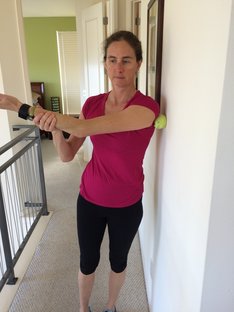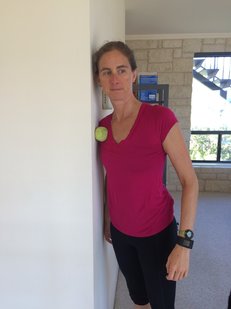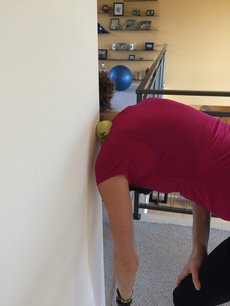|
Shoulder overuse injuries are very common within the swimmer population whether it be high school, college or masters level participation. A study published in 1995 reveals that 47% of collegiate swimmers and 48% of masters swimmers report experiencing shoulder pain lasting 3 weeks or more.[1] More recently, studies have shown as high as 91% of swimmers aged 13-25 reporting shoulder pain, 84% of those had positive impingement signs, and 69% of those studied with MRI had supraspinatus tendinopathy.[2] One adaptation seen with swimmers experiencing shoulder pain is a decrease in active upward rotation of the scapula with shoulder elevation following a fatiguing bout of swimming.[3] Possible causes for this adaptation can be tonic or shortened levator scapula, weakness of serratus anterior, immobile and kyphotic thoracic spine, weak or fatigued infraspinatus, and adaptively shortened pectoralis minor. Other possible factors contributing to impingement symptoms or overuse tendinosis among swimmers include strength imbalances between subscapularis and infraspinatus, and activation imbalances between upper trap and lower trapezius. In an effort to maintain healthy shoulders in swimmers, it is important to remember that the shoulder girdle articulates with the rib cage and, therefore, the rest of the trunk. So the posture and dynamic control of the trunk can influence how well the shoulder functions. The classic standing “swimmer posture” is characterized as a head forward posture, rounded shoulders, increased lumbar lordosis, genu recurvatim (hyperextended knees), kyphotic thoracic spine (rounded upper back), and flared lower ribs. This posture can lead to poor abdominal and gluteal activation, not to mention altered breathing efficiency and dysfunctional shoulder mechanics. When the shoulders are rolled forward, the shoulder socket is angled downward and the muscles that stabilize the shoulder "ball" in the "socket" (rotator cuff muscles) have to work much harder. The rotator cuff is susceptible to fatigue due to the sheer number of revolutions that occur with a typical swim workout, no need to overload those same muscles with faulty posture. When attempting to strengthen the scapular retractors and depressors, a common compensation for a stiff thoracic spine and poor mid/lower trapezius activation is to further extend the lumbar spine. If a swimmer is only able to retract or depress the scapulae by extending the lumbar spine, this has adverse consequences in the water. When swimming, the hips will drop, the abdominal muscles will be harder to recruit; making the body position less hydrodynamic and the trunk a less stable base for propulsion. Here are some examples of exercises to address some of those typical areas of tightness, immobility or weakness associated with the classic "swimmer posture". This content is for informational purposes only and does not constitute medical advice; the Content is not intended to be a substitute for professional medical advice, diagnosis, or treatment. Always seek the advice of a physician or other qualified health provider with any questions you may have regarding a medical condition. Never disregard professional medical advice or delay in seeking it because of something you have read on this website. Thoracic Extension Self-Mobilization Purpose: increase mobility of thoracic spine, decrease kyphotic postures Instructions: Lie on back with knees bent and foam roller behind mid back with foam roller perpendicular to spine. Support neck by clasping hands behind neck with elbows straight forward. Stretch upper back into extension over roll by reaching elbows upward. Pressure on, pressure off. 3-4 reps in 2-3 different positions along mid back. NOTE: Important to keep pelvis tucked under with abs activated in order to avoid excessive lumbar extension. Pectoralis Stretch on Foam Roller Purpose: Stretch pectorals, facilitate posterior pelvic tilt and normalize lumbar extensor tone, increases abdominal activation Instructions: Lie on back on foam roller with knees bent and flat on floor. Inhale with arms in front of face with elbows bent. Exhale, tucking pelvis under and closing ribs as you bring arms into "goal post" position. Inhale to start position. Quadruped Belly Lift with Upper Extremity March Purpose: Facilitate posterior pelvic tilt, activate abdominals with rotational stabilization, close down the ribs to allow diaphragm to relax and normalize psoas tone, and activation of serratus anterior Instructions: Start on hands and knees. Inhale. Exhale and tuck pelvis. Inhale holding tuck. Exhale lift knees and tuck further. Inhale, holding tuck. Exhale, tuck further and lift R hand without twisting or leaning. Inhale and lower hand. Alternate hands. Supine Scapular Overhead Press with Tubing Purpose: Re-educate and strengthen the serratus anterior without thoracic compensations for optimal upward scapular rotation. Instructions: Lie on back with knees bent and feet flat. Tubing wrapped around back with an end in each hand. With arms straight and arms angled slightly upward toward head. Keep pelvis tucked under and press shoulders away from floor and slowly return to start. Prone Scapular Combo on Stability Ball with Posterior Pelvic Tilt Purpose: Facilitate posterior pelvic tilt and abdominal recruitment, facilitate lower trapezius activation without over-activation of upper trapezius, and strengthen infraspinatus. Instructions: Prone over stability ball with body in a plank position Tuck pelvis under and engage abs, "pressing pubic bone into ball". Start with arms at side with palms in. Squeeze blades down and back. Keep blades down and back as you bring arms to a "T" with thumbs pointed up. Then bring arms to a wide "Y" with thumbs up. Back to the "T" and then back to side. Don't let low back arch. Actively press shoulder blades downward toward hips through the movement. Can also bring knees to floor if having difficulty maintaining posterior pelvic tilt. Self Myofascial Release Purpose: decrease pain and improve mobility of soft tissue to scapular and rotator cuff musculature to facilitate normal scapular mechanics. Posterior Rotator Cuff Instructions: Stand with tennis ball pressed between back side of shoulder blade and wall. Find tender or tight spot, pin it with the tennis ball and then passively or actively move the involved arm (upward or across chest) until muscles relax. Pectorals Instructions: Facing a doorframe, place tennis ball between pectoralis muscle and doorframe with arm in “cactus position” or at side. Slowly turn sternum away from ball until feel stretch in chest. Upper Trapezius/ Levator Scapula Instructions: In door frame, place ball between doorframe and upper trapezius. Pin the tight areas and gently move neck until you feel muscles relax. References [1] Stocker D, Pink M, Jobe FW. (1995). Comparison of shoulder injury in collegiate- and master’s-level swimmers. Clin J Sport Med 5 (1): 4-8.
[2] Sein ML, Walton J, Linklater J, Appleyard R, Kirkbride B, Kuah D, Murrell GAC. (2010). Shoulder Pain in elite swimmers: primarily due to swim-volume-induced supraspinatus tendinopathy. Br J Sports Med 44(2): 105-13. doi: 10.1136/bjsm.2008.047282 [3] Su KP, Johnson MP, Gracely EJ, Karduna AR. (2004). Scapular rotation in swimmers with and without impingement syndrome: practice effects. Med Sci Sports Exerc 36(7): 1117-23.
2 Comments
aaron
2/1/2019 08:23:37 pm
as a swimmer I can say, these are great!
Reply
Leave a Reply. |
AuthorKendal Jacobson, PT Archives
January 2023
Categories |
|
P 512-736-6742
F 877-736-5233 10601 Pecan Park Blvd, Suite #302 Austin, Texas, 78750
|
|




 RSS Feed
RSS Feed